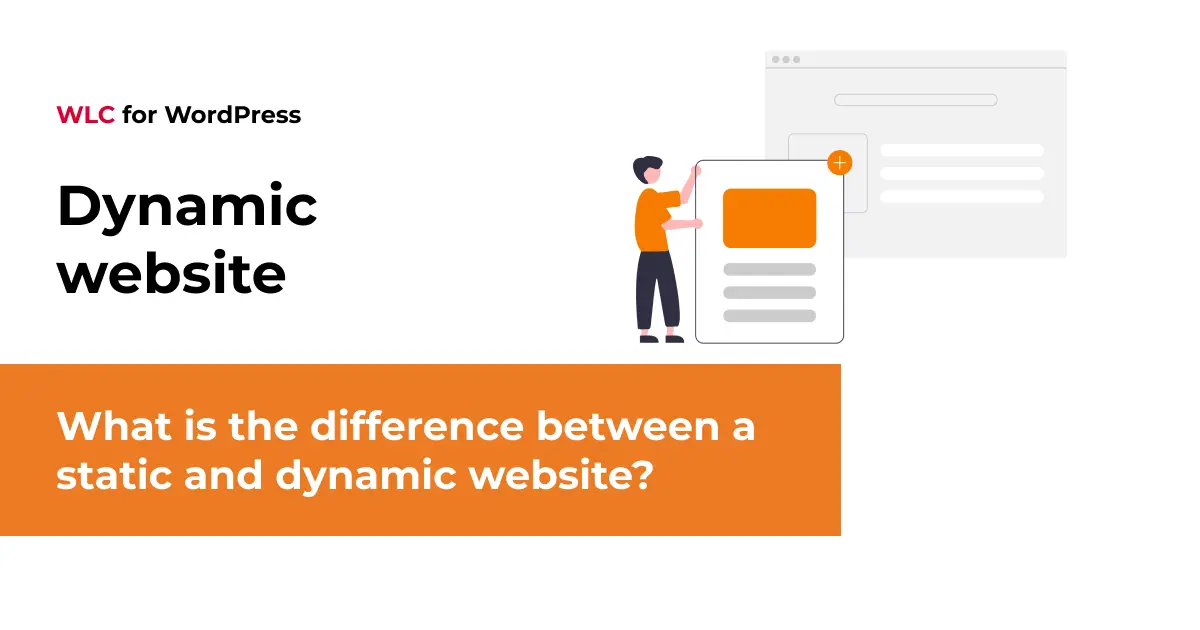Category: WordPress
What is the difference between a static and dynamic website?

Choosing between a static and dynamic website can feel overwhelming, especially when you’re trying to balance functionality, budget, and future growth plans. Whether you’re launching your first business website or considering a platform migration, understanding the fundamental differences between these two approaches will save you time, money, and countless headaches down the road.
This decision impacts everything from your hosting costs to your ability to scale, so let’s explore the technical foundations and practical implications that will guide you towards the right choice for your specific needs.
Understanding website fundamentals: what you need to know
At its core, every website operates on a simple principle: delivering content to visitors through their web browsers. However, how that content gets delivered makes all the difference in terms of performance, functionality, and maintenance requirements.
Website architecture falls into two primary categories: static and dynamic. The distinction lies in where and when your content is processed. Static websites serve pre-built files directly to users, whilst dynamic websites generate content in real-time based on user requests and database interactions.
Understanding this fundamental difference helps you evaluate crucial factors like development complexity, ongoing maintenance needs, security considerations, and scalability potential. These architectural choices directly influence your project timeline, budget allocation, and long-term digital strategy.
What is a static website and how does it work?
A static website consists of fixed HTML, CSS, and JavaScript files that remain unchanged until manually updated. Think of it as a digital brochure where every page exists as a complete, pre-written document stored on a web server.
When someone visits your static site, the server simply locates the requested file and sends it directly to their browser. There’s no database querying, no server-side processing, and no content generation happening behind the scenes. What you see is exactly what’s stored on the server.
Technical architecture of static websites
Static websites rely on three core technologies working together. HTML provides the structural foundation and content, CSS handles visual styling and layout, whilst JavaScript adds interactive elements and client-side functionality. These files are typically stored on a content delivery network (CDN) or simple web server.
The hosting requirements are minimal since there’s no need for database servers, server-side scripting languages, or complex server configurations. This simplicity translates to faster loading times, enhanced security, and reduced hosting costs.
What is a dynamic website and how does it function?
Dynamic websites generate content on-the-fly using server-side technologies and database systems. Rather than serving pre-built pages, these sites construct each page in response to user requests, pulling information from databases and processing it through server-side scripts.
When you visit a dynamic website, the server receives your request, queries relevant databases, processes the information through programming languages like PHP or Python, and then assembles a customised HTML page specifically for that moment and user.
The role of content management systems
Most dynamic websites utilise content management systems (CMS) like WordPress, which provide user-friendly interfaces for managing content without requiring coding knowledge. These systems handle the complex database interactions and content generation processes behind the scenes.
Dynamic websites excel at personalisation, user accounts, e-commerce functionality, and content that changes frequently. They can display different information based on user preferences, location, purchase history, or other variables stored in their databases.
Key differences: static vs dynamic website comparison
| Aspect | Static Websites | Dynamic Websites |
|---|---|---|
| Performance | Lightning-fast loading times | Variable, depends on server processing |
| Security | Minimal attack surface | Requires ongoing security maintenance |
| Maintenance | Low, mainly content updates | Regular updates and monitoring needed |
| Scalability | Excellent for traffic spikes | Requires server resource planning |
| Development Cost | Lower initial investment | Higher due to complexity |
| Functionality | Limited to client-side features | Unlimited server-side capabilities |
The performance difference is particularly striking. Static sites can handle massive traffic surges without breaking a sweat, whilst dynamic sites may require load balancing and server scaling to manage similar volumes.
The choice between static and dynamic isn’t about which is “better” – it’s about which architecture aligns with your specific requirements, budget, and long-term goals.
When to choose static websites for your project
Static websites shine in scenarios where content remains relatively stable and complex user interactions aren’t required. Portfolio websites, company brochures, landing pages, and documentation sites are perfect candidates for static architecture.
Consider static websites when you need maximum performance on a limited budget. They’re ideal for businesses that update content infrequently, prioritise fast loading times, and want minimal ongoing maintenance responsibilities.
Static sites also excel for projects with tight deadlines, as they require less development time and fewer technical considerations during the build process.
When dynamic websites are the right solution
Dynamic websites become essential when you need user accounts, personalised content, e-commerce functionality, or frequently updated information. Any site requiring user-generated content, complex search functionality, or integration with external systems will benefit from dynamic architecture.
E-commerce platforms, membership sites, news portals, and social networks all require the flexibility and database-driven functionality that only dynamic websites can provide. The ability to manage content through user-friendly interfaces makes dynamic sites particularly valuable for teams without technical expertise.
WordPress as a dynamic website solution: benefits and considerations
WordPress represents the gold standard for dynamic website development, powering millions of websites worldwide. Its flexibility allows for everything from simple blogs to complex e-commerce platforms and custom web applications.
The platform’s strength lies in its extensibility through themes and plugins, enabling custom WordPress website development that can meet virtually any business requirement. WordPress custom development opens possibilities for multilingual business sites, advanced e-commerce platforms, e-learning systems, and multi-vendor marketplaces.
WordPress’s mature ecosystem provides solutions for complex integrations with ERP and CRM systems, making it an excellent choice for businesses requiring sophisticated functionality. The platform’s flexibility means you can start simple and scale complexity as your needs evolve.
However, WordPress sites require ongoing maintenance, security updates, and performance optimisation. The trade-off between functionality and maintenance overhead is something to consider carefully during your planning phase.
For growing businesses, especially those running e‑commerce or content‑heavy platforms, dynamic websites built on WordPress and WooCommerce offer unmatched flexibility and scalability. At White Label Coders, we specialize in custom WordPress development for enterprises that need secure, high‑performance solutions integrated with CRMs, ERPs, and marketing tools. By designing clean, optimized architectures with custom Gutenberg blocks and WooCommerce enhancements, we ensure that your site is not only functional but also ready to grow with your business.
Making the right choice: your website decision framework
Your website architecture decision should start with a clear assessment of your functional requirements. Do you need user accounts, e-commerce capabilities, or content that changes frequently? If so, dynamic architecture is likely your path forward.
Consider your team’s technical capabilities and available resources for ongoing maintenance. Static sites require minimal upkeep, whilst dynamic sites need regular attention to security, updates, and performance optimisation.
Budget considerations extend beyond initial development costs. Factor in hosting requirements, maintenance needs, and potential scaling costs as your site grows. Static sites generally offer more predictable long-term costs, whilst dynamic sites may require additional investment as traffic and functionality expand.
Think about your content management needs. Will non-technical team members need to update content regularly? Dynamic CMS platforms provide user-friendly interfaces, whilst static sites typically require technical knowledge for updates.
The decision between static and dynamic websites ultimately comes down to matching your technical requirements with your available resources. Both approaches have their place in modern web development, and understanding their strengths helps you make an informed choice that supports your long-term success.






